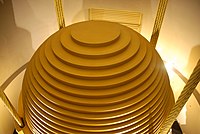
Photo from wikipedia
Abstract Due to the windless-air-induced added mass and damping effects, the mechanical frequency and damping ratio of a bridge deck model in wind tunnel test are usually under-estimated and over-estimated,… Click to show full abstract
Abstract Due to the windless-air-induced added mass and damping effects, the mechanical frequency and damping ratio of a bridge deck model in wind tunnel test are usually under-estimated and over-estimated, respectively. In this study, the vertical and torsional added mass and damping and their effects on the mechanical frequency and damping ratio of an ideal plate and five typical bridge decks are thoroughly investigated based on single degree-of-freedom free vibration numerical simulations. The aerodynamic forces are linearly expressed as functions of vibrating accelerations, velocities, added mass coefficients, and added damping coefficients. The discrepancies between two-dimensional (2D) and three-dimensional (3D) simulations are found to be small. The numerical simulation accuracy is validated through comparison with the results from the Theodorsen expression and forced vibration simulations. It is found that the added mass coefficients are insensitive to the vibration amplitudes, while the added damping coefficients almost linearly increase with the amplitudes. Based on the added mass and damping coefficients, the vertical and torsional air-induced frequency reduction coefficients and aerodynamic damping ratios are calculated. Both the frequency reduction coefficients and aerodynamic damping ratios are closely related to deck configurations and model mass/mass moment of inertia, while independent of vibration frequencies. For the concerned six section models, the vertical and torsional frequency reduction coefficients are mainly located in the ranges of (1.0%, 2.5%) and (0.4%, 1.2%), respectively. The aerodynamic damping ratios are significantly dependent on the vibration amplitudes and may exceed the mechanical damping ratios for large amplitude cases. Based on numerical simulations, the mechanical frequency and damping ratio of a spring-suspended deck model can be identified by excluding the added mass and damping effects.
Journal Title: Journal of Wind Engineering and Industrial Aerodynamics
Year Published: 2019
Link to full text (if available)
Share on Social Media: Sign Up to like & get
recommendations!